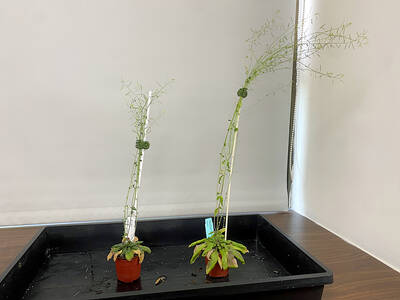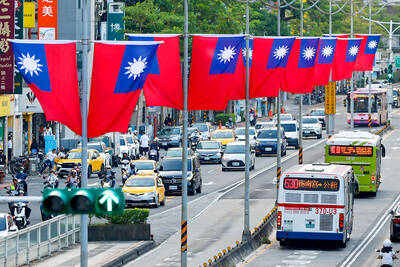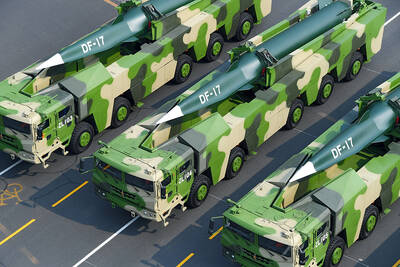The best kind of energy is conservation, President William Lai (賴清德) said yesterday, adding that Taiwan is willing to address climate challenges jointly with China and other countries.
Climate change poses challenges to national resilience and sustainable development, with Typhoon Krathon — which made landfall in Kaohsiung earlier this month — a prime example, Lai told the second meeting of the National Climate Change Committee.
Taiwanese must work together to build up national resilience against such challenges, and Taiwan would be “willing to bolster cooperation with China and other countries to deal with climate change,” he said.

Photo: CNA
While the 2015 Paris Agreement requires countries to update nationally determined contributions (NDCs) every five years, the 26th session of the Conference of the Parties (COP26) to the UN Framework Convention on Climate Change has increased the frequency to every two years to expedite the global carbon-reduction process, Lai said, adding that the next NDC submission date is early next year.
To ensure stable and resilient energy supply, policies and measures revolving around “the second energy transition” would be implemented, including a carbon-fee program launched this month and to be implemented from next year, he said.
The government would promote in-depth energy conservation and applications of energy-storage technology to facilitate the energy transformation, as well as the development of next-generation industries, Lai said.
More renewable energy and green growth opportunities would be explored to steadily move toward the net zero goal by 2050, he added.
Taiwan plays a pivotal role in the global technology supply chain and must step up climate action to boost its international industrial competitiveness, as well as develop NDCs in line with international trends, Lai said.
Stable power supply is the cornerstone of Taiwan’s economic development, as it would attract foreign investments to support the domestic industrial ecosystem, he said.
“The best energy comes from energy saving,” Lai said, adding that energy conservation is more efficient than developing electric power sources and one of the most effective carbon reduction strategies.
To boost energy efficiency is an international consensus and trend, considering that COP28 last year set a goal to double the global average annual rate of energy efficiency improvements to 4 percent from 2 percent by 2030, he said.
The government would continue to implement energy-saving policies and encourage in-depth energy conservation across all industries, Lai said.
From high-carbon emissions companies to hospitals, schools, families and individuals, everyone is required to take part in the in-depth energy conservation campaign along with the government to form a strong team, he added.
Energy service companies (ESCo) would also be a crucial part in the program, as they could formulate highly cost-efficient energy saving plans tailored to each company, Lai said, adding that government funds would be allocated to incentivize or subsidize investments in industrial energy conservation.
The government would collaborate with insurance companies to establish ESCo mechanisms to provide funding for companies to advance equipment and manufacturing processes, he said.
While lower electricity fees would benefit investors, insurance premiums would be invested into national infrastructure, forming a circular economy, Lai said.
As long as everyone works together to make the energy transition reality, Taiwan would be able to seize the opportunity of ensuring sustainable growth for generations to come, he said, adding that the government would follow the examples of the UK and Japan to accelerate net zero carbon emissions.

Taiwanese scientists have engineered plants that can capture about 50 percent more carbon dioxide and produce more than twice as many seeds as unmodified plants, a breakthrough they hope could one day help mitigate global warming and grow more food staples such as rice. If applied to major food crops, the new system could cut carbon emissions and raise yields “without additional equipment or labor costs,” Academia Sinica researcher and lead author the study Lu Kuan-jen (呂冠箴) said. Academia Sinica president James Liao (廖俊智) said that as humans emit 9.6 billion tonnes of carbon dioxide compared with the 220 billion tonnes absorbed

The Taipei Mass Rapid Transit (MRT) Wanda-Zhonghe Line is 81.7 percent complete, with public opening targeted for the end of 2027, New Taipei City Mayor Hou You-yi (侯友宜) said today. Surrounding roads are to be open to the public by the end of next year, Hou said during an inspection of construction progress. The 9.5km line, featuring nine underground stations and one depot, is expected to connect Chiang Kai-shek Memorial Hall Station to Chukuang Station in New Taipei City’s Jhonghe District (中和). All 18 tunnels for the line are complete, while the main structures of the stations and depot are mostly finished, he

Taipei is to implement widespread road closures around Taipei 101 on Friday to make way for large crowds during the Double Ten National Day celebration, the Taipei Department of Transportation said. A four-minute fireworks display is to be launched from the skyscraper, along with a performance by 500 drones flying in formation above the nearby Nanshan A21 site, starting at 10pm. Vehicle restrictions would occur in phases, they said. From 5pm to 9pm, inner lanes of Songshou Road between Taipei City Hall and Taipei 101 are to be closed, with only the outer lanes remaining open. Between 9pm and 9:40pm, the section is

China’s plan to deploy a new hypersonic ballistic missile at a Chinese People’s Liberation Army Rocket Force (PLARF) base near Taiwan likely targets US airbases and ships in the western Pacific, but it would also present new threats to Taiwan, defense experts said. The New York Times — citing a US Department of Defense report from last year on China’s military power — on Monday reported in an article titled “The missiles threatening Taiwan” that China has stockpiled 3,500 missiles, 1.5 times more than four years earlier. Although it is unclear how many of those missiles were targeting Taiwan, the newspaper reported